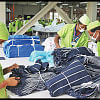The non-mystery behind Khulna city's declining population

Khulna, the third largest city of Bangladesh, with a current population of approximately 950,000 and land area spanning 40.8 square kilometres, is the only city in the country which has been experiencing a negative population growth over the last two decades.
Between 2002 and 2021, the city had a negative annual average population growth of -1.38 percent. In 2002, Khulna, for the first time, registered a negative population growth of -1.51 percent over its population in 2001. In the previous 50 years, between 1950 and 2001, the city had experienced a substantial increase in population with an average annual growth of 6.26 percent. The city population reached its peak of 1,255,000 in 2001.
The urbanisation process in Khulna city began as early as in the 1830s due to the growth of commerce and manufacturing sectors. The city was declared as a municipality in 1884. Khulna was upgraded to a City Corporation in 1990. The city has a linear development along Rupsha and Bhairab rivers and has a natural transportation advantage which enabled rapid industrialisation of the area in the 1950s and 1960s. The city's population continued to grow as a result of both natural increase and positive net in-migration.
However, since 2002, the natural increase continued but the negative net in-migration got to the extent that overall population growth became negative. The decline in economic activities in Khulna city over the last two decades, resulting from the closure of state-run jute and textile mills, newsprint mills, match factories, jute baling presses, hardboard mills, etc, and consequently, a rise in migration from the city to adjacent suburbs and other towns has resulted in the depopulation of Khulna city.
Although the overall urban population has grown at a rate of 3.8 percent in Bangladesh during the last two decades, the closure of many state-run jute and textile mills has rendered thousands of workers unemployed in the formal sector. Khulna city is thus facing an economic downturn.
In recent years, some private investment has come to Khulna city mostly in the service sector such as for hotels, hospitals, tourism, and education. But these employ fewer people than the shuttered industries used to do.

There are several factors, however, besides the closure of industries that contribute to the net migration of Khulna city's population. These are: rise in land prices, increase in the housing prices, shortage of serviced land for building construction, poor public services, a paucity of city buses, and faster growth of other cities in the south-west (like Jashore, Satkhira, Bagerhat, and Mongla port) where new private sector industries are developing.
One other important factor that explains the negative urbanisation rate in Khulna is a shift of the city's land use, caused by two factors: 1) the development of a major transportation route, that is, the Khulna-Jashore bypass road; and 2) the establishment of institutions for higher education such as Khulna University, Khulna University of Engineering and Technology, Khulna Agricultural University and Sheikh Hasina Medical University.
These have shifted human expansion along the Khulna-Jashore bypass road and around the university areas.
Khulna city experienced growth towards its south-eastern, south-western, southern, and northern sides outside the official city boundaries. Between 1991 and 2020, the city expanded 17 square kilometres outside the city corporation area. This urban sprawl was caused by land-use shifts in the fringe areas of the city, which became more attractive for settlement due to improved road networking, employment opportunities, and cheaper land.
Overall, Bangladesh has undergone significant economic transformation in the last four decades and the industrial sector now constitutes 34 percent of our GDP. Thus, the decline of industrialisation in Khulna city should be taken seriously so that this trend can be reversed and the city can contribute significantly to the GDP again.
The Sustainable Development Goals (SDGs) envisage that every part of the country should enjoy the fruits of development by ensuring sustained and inclusive economic growth, and decent work for all. In this context, Khulna City Corporation, Khulna Development Authority, Khulna Chamber of Commerce and Industries, and relevant line ministries must sit together to agree on suitable strategies to revive the economic importance of Khulna and encourage industrialisation of the area. Many national and regional policies that affect Khulna city's economy were employed without consulting these local bodies.
In the future, to ensure sustainable, steady, and healthy urbanisation of the country, urban local governments should be included in the decision-making process.
The Padma Multipurpose Bridge has now well-connected the south-west region of the country and thus guarantees ample opportunities for movement of people and industries. The opportunities granted by the bridge must be explored to their maximum possible extent so that when the impact evaluation of the Padma Bridge is carried out in a few years, we do not end up with a disappointing result.
Khulna city can have vibrant economic activities once again, only if deliberate policy decisions are taken.
The two planned economic zones in Rupsha and Batiaghata areas close to Khulna city have potentials for reviving the economic importance of the city if industries are established there. With the construction of Padma Bridge, it is now possible to supply gas to Khulna area and this could ensure the establishment of various large- and medium-sizes industries for jute, leather, salt, garments, cement, rods, agriculture, food, and fish processing.
The domination of informal sectors in Khulna city has encouraged the influx of thousands of poor families from the southern districts, who now form about one-third of the city's total population. This translates to almost 300,000 people who live in 1,100 low-income settlements, mostly along the two rivers. This trend needs to be reversed by investing in basic public services, and by industrialising and opening up opportunities for formal employment in the city, thereby reducing urban poverty.
A sustainable urban regeneration strategy along with the effective implementation of the Khulna Master Plan are required for building a vibrant city economy.
Dr Nawshad Ahmed, an ex-UN official, is an economist and urban planner.

 For all latest news, follow The Daily Star's Google News channel.
For all latest news, follow The Daily Star's Google News channel. 









Comments